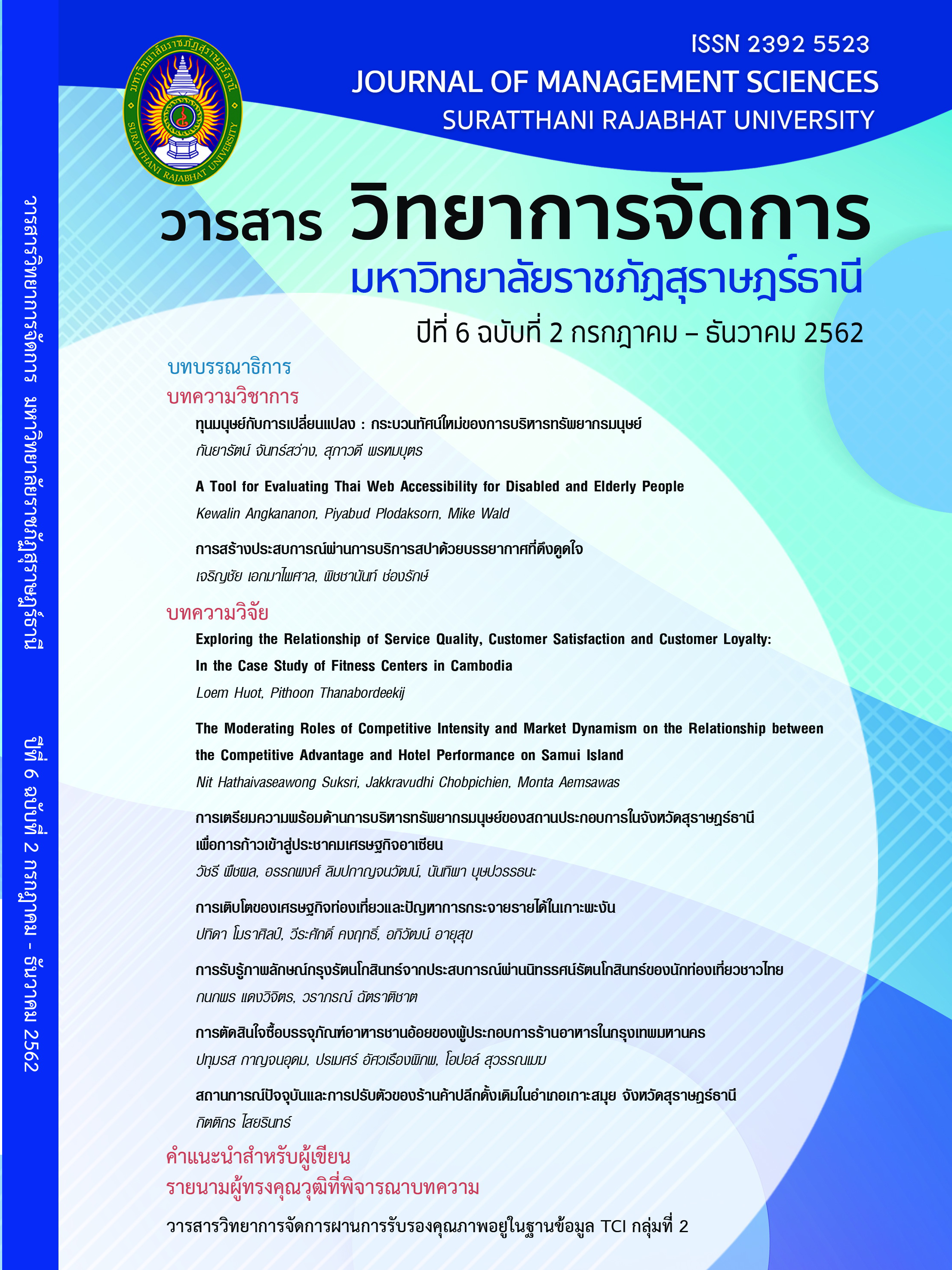A Tool for Evaluating Thai Web Accessibility for Disabled and Elderly People
Main Article Content
Abstract
There are rapidly increasing numbers of websites and online services in Thailand which leads to more web content being created daily. Developers should consider the importance of Web accessibility when creating their content. At present, Thai developers have not had much knowledge and experience in developing web accessibility and there is a lack of guidelines and tools available in Thailand. Therefore, the majority of web content which are created by Thai developers are not accessible to those with disabilities. The solution to this problem is to create the Thai Evaluation Criteria which is applicable to Thai Websites as well as creating a tool which will allow developers to evaluate their created web contents. The Thai Evaluation Criteria were created through a series of steps which involved the use of expert reviews and validation, focus groups, and experiments to check the usability of the Thai Evaluation Criteria. This paper explains the WebThai2Access website which allows the users to evaluate websites based on the Thai Evaluation Criteria and which is based on the Web2Access website.
Article Details
References
Angkananon K., Wald M., Ploadaksorn P. (2017) Developing and Evaluating a Thai Website Accessibility Checker. In: Stephanidis C. (eds) HCI International 2017 – Posters' Extended Abstracts. HCI 2017. Communications in Computer and Information Science, vol. 713.Springer, Cham.
Announced from Ministry of Industry in titled Defiing Industry Standard of Web Content Accessibility Guideline 2012. (2013, February 27). Government Gazette. No. 130 section 27. Pages 17 - 44.
Caldwell, B., Cooper, M., Reid, L.G. & Vanderheiden, G. (2008). Web Content Accessibility Guidelines (WCAG) 2.0. Retrieved on 17 June 2016, from https://www.w3.org/TR/WCAG20/.
Carter, J. and Markel, M. (2001). Web accessibility for people with disabilities: An introduction for web developers. IEEE Transactions on Professional Communication, 44(4), pp.225 - 233.
Centeno, V.L., Kloos, C.D., Fisteus, J.A. and Alvarez, L.A. (2006). Web Accessibility Evaluation Tools:A Survey and Some Improvements. Electronic Notes in Theoretical Computer Science,157 (2006), pp.87-100.
Electronic Government Agency Public Organisation. (2012). Government Website Standard. Retrieved on 25 June 2016, from
Gunderson, J., Rangin, H.B. and Hoyt, N. (2006). Functional Web Accessibility Techniques and Tools from the University of Illinois. In: University of Illinois, Assets '06 Proceedings of the 8th international ACM SIGACCESS conference on Computers and accessibility. Portland,Oregon, USA, October 22 - 25 2006. New York: ACM.
Hay, M. (2016). WCAG 2.0 / Accessibility, is it an impossible standard that provides the basis for excuses? Retrieved on 31 May 2018, from
Henry, S.L. (2006). Understanding Web Accessibility. Retrieved on 15 June 2016, from
Kamollimsakul, S., Petrie, H. and Power, C. (2014). Web Accessibility for Older Readers: Effects of Font Type and Font Size on Skim Reading Webpages in Thai. In: University of York, 14th International Conference, ICCHP 2014. Paris, France, 9 - 11 July 2014. Switzerland:Springer International Publishing.
Lewthwaite, S. (2014). Web accessibility standards and disability: developing critical perspectives on accessibility. Disability and Rehabilitation, 36(16), pp.1375 - 1383.
Ministry of Information and Communication Technology. (2010). Thai Web Content Accessibility Guidelines 2010. Retrieved on 19 June 2016, from
Mitsamarn, N., Gestubtim, W. and Junnatas, S. (2007). Web accessibility: a government's effort to promote e-accessibility in Thailand. In: National Electronics and Computer Technology Center (NECTEC), i-CREATe '07 Proceedings of the 1st international convention on Rehabilitation engineering & assistive technology: in conjunction with 1st Tan Tock Seng Hospital Neurorehabilitation Meeting. Singapore, 23 - 26 April 2007. New York: ACM.
Molinero, A.M., Kohun, F.G. and Morris, R. (2006). Reliability in Automated Evaluation Tools for Web Accessibility Standards Compliance. Issues in Information Systems, 7(2), pp.218 - 222.
The Thai Department of Empowerment of Persons with Disabilities. (2016). Report on Disability Situation in Thailand. Retrieved on 1 July2016, from http://dep.go.th/sites/default/fies/fies/news/Report_PWDS_SEP2559.pdf.
Thai web accessibility. (2013). Website Monitoring Report. Retrieved on 28 June 2016, from http://audit.thaiwebaccessibility.com/ Thailand Ministry of Information and Communication Technology. (2010).
Thailand Information and Communication Technology (ICT) Policy Framework (2011 - 2020).Retrieved on 19 June 2016, from
The National Statistical Offie. (2014). Preliminary Results Survey of the Elderly in Thailand.Retrieved on 1 July 2016, from https://www.m-society.go.th/article_attach/14494/18145.pdf
Wald, M., Draffan, E.A., Newman, R., Skuse, S. & Phethean, C. (2012). Access Toolkit for Education. In: ECS, University of Southampton, UK, 13th international conference on Computers Helping People with Special Needs - Volume Part I. Linz, Austria, July 2012. Heidelberg:Springer
W3C. (2005a). Introduction to Web Accessibility. Retrieved on 15 June 2016, from
W3C. (2005b). Selecting Web Accessibility Evaluation Tools. Retrieved on 30 June 2016, from
W3C. (2008). Web Content Accessibility Guidelines (WCAG) 2.0. Retrieved on 30 May 2018, from https://www.w3.org/TR/WCAG20/.
W3C. (2012). Diversity of Web Users. Retrieved on 16 June 2016, from https://www.w3.org/WAI/intro/people-use-web/diversity#auditory
W3C. (2014a). WCAG 2.0 Translations. Retrieved on 18 June 2016, from
W3C. (2014b). Semi-automated accessibility checkers. Retrieved on 31 May 2018, from
W3C. (2015). WAI Guidelines and Techniques. Retrieved on 17 June 2016, from https://www.w3.org/WAI/guid-tech.html>
W3C. (2016a). ACCESSIBILITY. Retrieved on 16 June 2016, from
W3C. (2016b). Web Accessibility Initiative (WAI). Retrieved on 17 June 2016, from
W3C.(2016c). How to Meet WCAG 2.0. Retrieved on 17 June 2016, from


